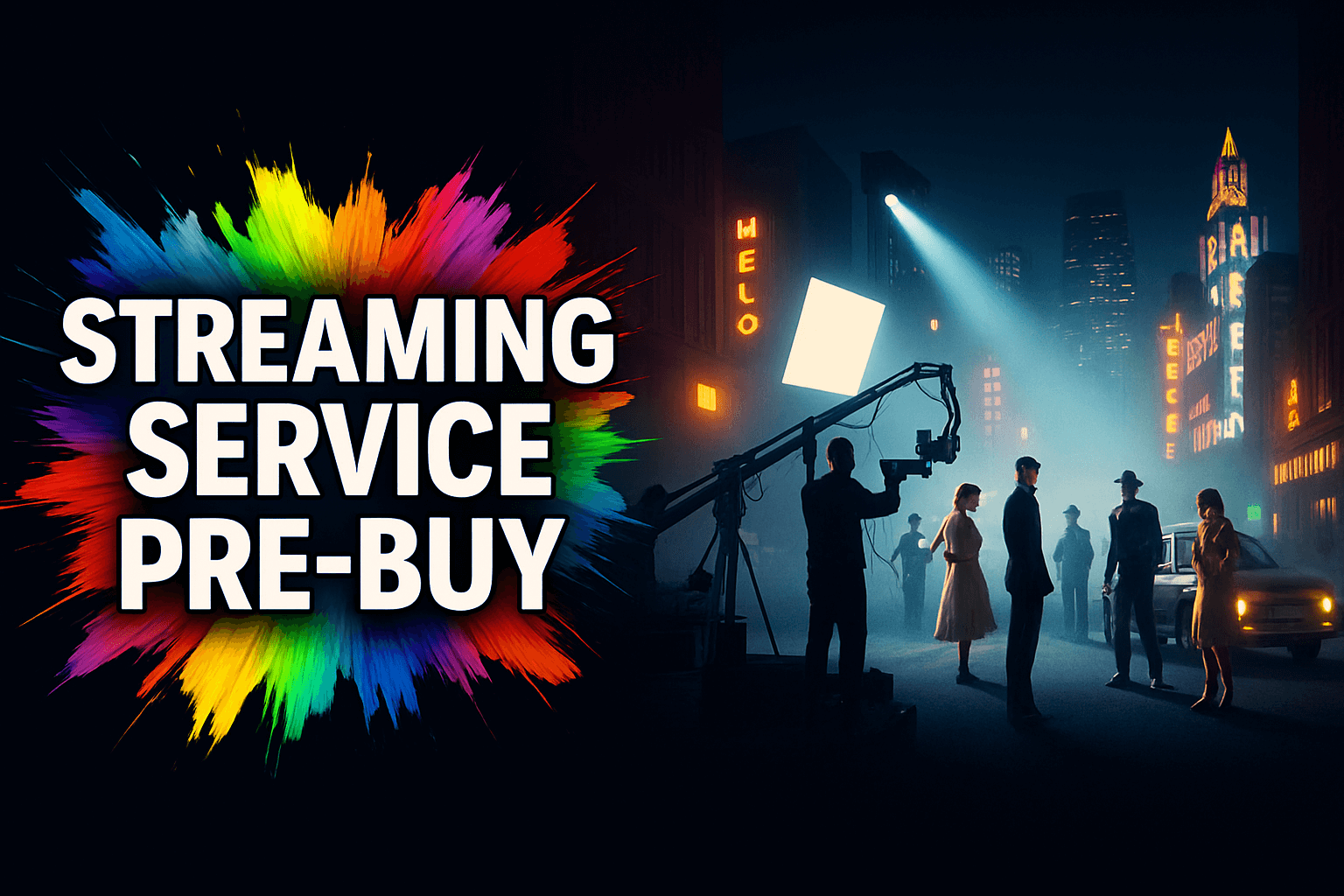Streaming Service Pre-Buy: A Guide to Tracking Content Opportunities

Introduction
The battle for subscriber attention is fiercer than ever, forcing media and entertainment companies to find new ways to secure premium, exclusive content. In this high-stakes environment, the streaming service pre-buy has emerged as a critical strategic tool.
This is a deal structure where a streamer or distributor acquires content rights—often for a specific territory or for global release—before a project has even finished production.
Rather than waiting for a film or series to be completed and presented at a market, savvy executives are now actively tracking projects in their earliest stages to get a head start.
This approach not only provides a competitive advantage but also allows for a more controlled approach to content slate management. I will break down how this process works, the core challenges in tracking these opportunities, and the data-driven solution that is transforming content acquisition.
Key Takeaways
| Core Challenge | Manually tracking thousands of film and TV projects in development and pre-production is slow, inefficient, and often leads to missed opportunities for securing pre-buy content. |
| Strategic Solution | Implementing a real-time, data-driven system to identify and monitor potential content opportunities in the earliest stages of the M&E supply chain. |
| Vitrina’s Role | Vitrina’s platform provides a centralized, global project tracker that gives content executives and distributors unprecedented early visibility into the development and production pipelines of thousands of companies. |
What is a Content Pre-Buy?
At its simplest, a content pre-buy is a transaction where a distributor or streamer commits to purchasing the rights to a piece of content—a film, a series, or a documentary—before its production is completed.
This differs from traditional content acquisition where a buyer acquires a finished product. The deal is typically based on the project’s early-stage materials: the script, a production budget, a cast list, or a high-level concept.
In essence, the buyer is betting on a project’s future potential, funding a portion of its production in exchange for exclusive distribution rights. This strategy has become commonplace, especially for smaller or independent productions that require upfront financing to get off the ground.
For a streaming platform, a successful pre-buy deal can be a game-changer, securing a future tentpole series or a slate of content that is exclusive to their platform, long before a competitor even knows it exists.
The Strategic Value of Pre-Buying for Streamers
The rationale behind pre-buying is rooted in two key strategic goals: mitigating risk and securing exclusive content. By entering the project at an early stage, a streaming service can influence creative decisions, ensuring the final product aligns with its brand and audience.
This co-production or co-financing model gives the streamer a vested interest in the project’s success and a greater degree of control over the creative process.
Beyond creative control, pre-buying provides a significant competitive advantage. As the content market becomes saturated, the ability to secure unique and high-quality titles is a key differentiator.
Pre-buying allows platforms to move ahead of the competition, locking in rights to a highly anticipated project before it becomes a bidding war at a major content market.
This proactive approach helps build a robust and diverse content slate, which is vital for attracting and retaining subscribers. For executives, this is not just about filling a library; it’s about building a sustainable and defensible content strategy that can withstand market fluctuations and the aggressive acquisition tactics of rivals.
The Core Challenge: Tracking Pre-Buy Opportunities at Scale
Despite the strategic benefits, the process of tracking pre-buy content opportunities is fraught with challenges. The primary obstacle is the decentralized nature of the global film and television market.
Information about a project’s development, financing, and production pipeline is often fragmented, buried in local trade publications, private emails, and word-of-mouth.
The lack of a centralized, real-time source of intelligence makes it nearly impossible for content executives to get a clear, comprehensive view of what’s happening globally.
The pain points are substantial. Manually researching and monitoring thousands of production companies, studios, and distributors is a monumental task that requires vast resources.
Content acquisition teams are forced to rely on inefficient methods like scouring a patchwork of websites, relying on personal networks, and attending dozens of industry events, all of which provide a limited and often outdated view.
This lack of visibility means that by the time a project is announced publicly, it may have already been pre-sold to a competitor. Without a streamlined system for tracking projects from their earliest stages, a streaming service risks being outmaneuvered in the race for exclusive content.
How Vitrina Empowers Content Acquisition Teams
Vitrina was built to solve this exact problem by providing a single source of truth for the entire M&E supply chain. The platform serves as a powerful project tracking engine, allowing executives to discover, filter, and monitor projects from their initial concept to final release.
Unlike traditional databases, Vitrina’s technology links a project to the companies, financiers, and key personnel involved, creating a dynamic, interconnected map of the industry. This is how I will break down the key capabilities:
Vitrina’s platform provides a strategic solution for content executives looking to get ahead of the pre-buy curve. The system’s core feature is its ability to provide early warning on projects as they move through the development and pre-production stages.
Users can filter by genre, budget, or key talent to identify projects that fit their content slate strategy, long before they hit the market.
For instance, a platform targeting fantasy content could use Vitrina to find all fantasy series in development with a specific production company in Europe, giving them a direct line to a potential pre-buy opportunity. This proactive approach moves the acquisition process from a reactive scramble to a strategic, data-driven initiative.
Furthermore, Vitrina’s extensive company profiles provide critical context that is often difficult to find. Users can view a company’s full project history, see their key collaborators, and identify their specialization.
This transparency is crucial for vetting potential partners. Instead of relying on a cold email or a brief meeting at a market, an executive can use Vitrina to understand a company’s past work and relationships.
This not only speeds up the due diligence process but also builds a foundation for a more informed and confident partnership.
Conclusion: The Future of Content Acquisition is Predictive
The era of reactive content acquisition is over. For streaming services and distributors to thrive, they must transition from simply buying finished products to strategically tracking and securing content in its earliest stages.
The ability to forecast what’s coming and where it’s coming from is no longer a luxury—it is a competitive necessity.
By providing a comprehensive, real-time view of the M&E supply chain, a platform like Vitrina gives executives the intelligence they need to move first, secure the most valuable titles, and build a content strategy that is both proactive and profitable.
This data-driven approach is the future of streaming service pre-buy and the key to winning the global content race.
Frequently Asked Questions
A content pre-buy is a deal where a distributor or streaming service acquires the rights to a film or TV show before its production is completed. The deal is based on early-stage materials like the script and creative talent, and it often provides upfront financing to the production.
Streaming services pre-buy content to secure exclusive rights and gain a competitive advantage in a crowded market. This strategy allows them to control their content slate, influence the creative direction of a project, and reduce the risk of being outbid once a project is completed.
Traditionally, finding pre-buy opportunities requires attending industry markets and relying on personal networks and public announcements. However, modern content executives use data platforms to track projects from their earliest development and production stages, providing a real-time view of the market.
The primary risk of a pre-buy is that the final product may not meet expectations. The deal is made based on an early concept, and production issues, creative changes, or talent availability can affect the quality and delivery. A solid contract and due diligence are crucial to mitigating these risks.

























